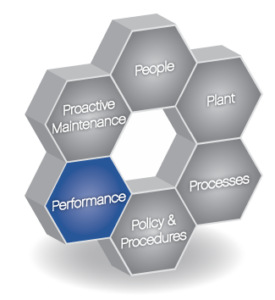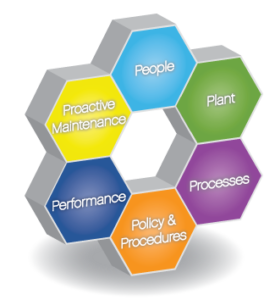“If we don’t measure it, it does not really exist.”
 I am not sure where the quote originated. Maybe it was derived from other very similar quotes that I have found through my research, but I did not create it and do not remember where I heard it and do not take credit for it. Nonetheless, it is a very true statement.
I am not sure where the quote originated. Maybe it was derived from other very similar quotes that I have found through my research, but I did not create it and do not remember where I heard it and do not take credit for it. Nonetheless, it is a very true statement.
This article is the continuing efforts to uncover the ever-elusive gem called Asset Management. I did not choose the reference of a “gem” randomly. Asset Management is comparable to a diamond or rare stone. When first found or unearthed, the diamond is very raw. It looks like many other stones; rough, lifeless and dull. As you make cuts to the diamond adding facets, then you add to its value, clarity, and beauty. Asset Management is much the same way. In the previous articles, we have made four major cuts or facets to the gem of Asset Management. This article will be the 5th. We have previously discussed the People, Plant, Processes, and Policy & Procedures cells within the Plant Hexcellence™ model and the corresponding supportive facets. We can now discuss Performance or the measurement of that progress or success. Additionally, you have heard me say in a previous article “If it is not important to my boss, therefore it is not important to me” (ABC’s of Asset Management). That is very true, and all too often the “boss” wants you to measure progress and success through metrics or Performance Indicators and report either directly or publically the results of the efforts.
What is a metric or indicator?
DEFINITION:
Metric/indicator is a data point of measurement. It is a snapshot of a specific numerical nature. The data point is usually associated with other points to indicate a trend or comparison.
It is very easy to be buried in data or metrics. Most organizations that I visit, I find that they are spending a lot of time collecting data for metrics that really have very little value, are not looked at by management or have outlived their purpose.
As we have said in the past, all things must be “Fit for Purpose, ” and metrics are no exception to that rule.
I have tried to make Metrics manageable by consolidating them into classes or categories. Additionally, using alliteration once again to help with retention of the material.
Money – All financial
Manpower – Personnel
Machines – Production
Methods – Work Processes
Materiel – MRO parts
Mandatory – Regulatory
Within each category, there are two types of indicators:
Lagging – A lagging indicator is “output” oriented, easier to measure but harder to improve or influence.* It uses data that is in the past to make decisions about direction and action in the future.
i.e., Making a decision on action for next quarter using data from the previous quarter’s financial record
Leading – A leading indicator is input oriented, harder to measure but easier to influence.* The indicator will have an impact on future performance. i.e., Preventive Maintenance Completion rate. If the completion is high, then there should be corresponding indicators of increased reliability as a result.
Issues of Metrics
Metrics can be a very powerful tool, but like most things, there are pros and cons related to using them. Being aware and understanding the limitations or issues with metrics may prevent you from falling into any pitfalls.
- No one indicator or Metric tells the whole story.
- For Example, One commonly used metric is overtime percentages. The benchmark for best in class is 8-13%. But, that is not the whole story. It is 8-13% with maintenance work being well planned and three weeks of a backlog. If the site has 2% overtime which by the parameters listed above may lead you to feel they have too many maintenance personnel. But, you dig a bit deeper and find out that they have more than ten weeks of backlog, they are running at 80% reactive/breakdown, and PM completion rate is at 50%.
- Metrics/ Indicators will drive the behavior of personnel, not the other way around. Be very careful what you measure as it may have exactly the wrong effect.
- A site wanted to improve the condition of the site. They chose to measure the number of work orders created by personnel and tied those numbers to their performance evaluation. The number of work orders tripled overnight, and the plant felt they had great The condition or readiness of the plant did not change, so what happened? What they found was that what used to take one work order, now took three. The work orders then had to be processed and managed by someone tripling the admin functional time. The result was no impact on site condition, and planners/supervisors were overwhelmed managing the number of work orders.
- Metrics and Indicators need to be well defined in terms of how to measure, and they need a reference point to be compared against relative to what is good or bad or neutral.
- For example, Maintenance cost as a percentage of the Replacement Asset Value. This number can be very different from industry to industry. Best in class for the process industry is 1.5-3%; whereas is in discreet manufacturing it can be 5% or mining 12%
- Metrics and Indicators are too easily manipulated to make them look the way you want them to look
- They can be and are often used for punitive action and therefore will be manipulated to ensure that personnel/sites remain in the best light.
- This example is for all the previous bullets – In Navy/Marine aviation, they had a program called SpinTac. It identified aircraft that had not flown in 100 days awaiting parts. It was designed to identify shortcomings in the supply line for major components. At some point, a senior officer started using a SpinTac % to measure his squadron commanders. A less than perfect SpinTac number (any number other than 0) was considered to be a huge red mark against the squadron commander. So squadron maintenance organizations would cannibalize a perfectly good airplane and take the needed part. They would place it on an aircraft about to exceed the 100-day mark. They would then take the aircraft and put it in a hover for 15 min, thus documenting it flew and thus did not go SpinTac. This would protect the commanding officer, but it defeated the whole purpose of the program of identification and improvement of parts shortages. This was a vicious cycle as the system did not have an indication of parts issue for the end user and therefore did not ramp up the production which created a situation where more aircraft would need to go SpinTac.
- Metrics that are created must have the What, Why, Who, How, When and Where*
- What will be measured?
- Why is it important?
- Who is Accountable for this measure?
- How exactly is the measure defined?
- Where will this measure be monitored?
- When is this information needed
- Metrics have a life cycle. Too often metrics are started to evaluate the progress of a true project. Once the project is over, the metrics and data collection often remain. They are adding no value but still time, energy and resources are used to collect the data. Ensure that Metrics still have a purpose. On an annual basis reevaluate the six questions listed above.
Summary
We like to keep score. We see this in much of the aspects of life. We see it from tracking the weight loss by weighing ourselves each morning to wearing technology to keep track of the way we sleep and how many steps we take each day. We are competitive by nature. We do not play sports and not keep score. We are always trying to find ways to track personal and professional performance. Be careful how, when and what you track as it can be more damaging than doing nothing.
Measuring performance is critical to any asset management program. Without knowing where you are and where you are going, it is difficult to keep your program on the right track. Also, selecting the right KPIs can be critical to the engagement and success of the program, as the wrong KPI can inadvertently drive the wrong behaviors.
Ideally, the business KPIs are selected and cascaded down to each role using a KPI tree. This ensures that each role has the appropriate KPI(s) that they can influence and supports the overall organizational objective. Far too often every in the organization gets OEE, even though they can’t directly influence it. Talk about demotivating! This is why Performance is important enough to have its own cell.
The Plant Hexcellence Model is a proven model that was developed by Scott Kelley at Geometric Reliability but is the model of choice for Eruditio, LLC. If you are interested in the Plant Hexcellence model for your site or organization, please contact [email protected].
Remember, to find success; you must first solve the problem, then achieve the implementation of the solution, and finally sustain winning results.
I’m James Kovacevic
Eruditio, LLC
Where Education Meets Application
Follow @EruditioLLC
References;
- Plant Hexcellence Model
- Free PDF Download on Plant Hexcellence – Performance
- Scott Kelley
- Geometric Reliability
- Managing Performance w/ Scott Kelley – Rooted In Reliability
- The Importance of an Asset Management Model – Rooted In Reliability
- The ABC’s of Asset Management – Rooted In Reliability
*This post was originally written by Scott Kelley of Geometric Reliability and modified by James Kovacevic


